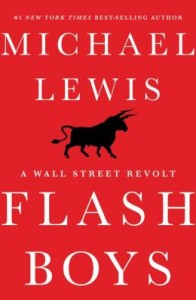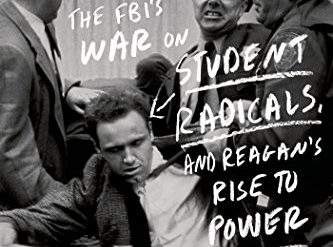
Bestselling Berkeley author Michael Lewis has been spending a lot of time in the East lately. After researching and writing his blockbuster fifteenth nonfiction book, Flash Boys, currently the country’s #1 best seller, he’s now juggling interviews and appearances triggered by the fallout. I can’t recall any book about the stock market that has ever before struck such fear into the denizens of Wall Street.
Estimated reading time: 6 minutes
Flash Boys tells the tale of the arcane and long-secret phenomenon known as high-frequency trading (HFT). The book reads like a thriller, showcasing the author’s legendary writing talent. Like the best fiction, it’s centered on people, not abstract processes or institutions, and the prose sings.
High-frequency trading cheats investors
As Lewis discovered, HFT is one of the ways that Wall Street cheats investors — and not just small-time investors like you and me, but also the elite folks who manage multi-billion-dollar pension funds and mutual funds (and thus, indirectly, us as well). Initially, the practice was limited to a handful of traders working in small, independent shops, many of them Russian immigrants with advanced degrees in math or science. However, in the course of Lewis’ exploration of this complex and clever technique to game the system, he learned that many of the big Wall Street banks bought into the process as well and gained enormous profits as a result. All together, Lewis assets, HFT has robbed the investing public of billions of dollars.
Flash Boys: A Wall Street Revolt by Michael Lewis (2014) 323 pages ★★★★★
HFT is no more than a computer-age version of the way Paul Julius Reuter made his name a century and a half ago by using telegrams and carrier pigeons to get the news to the London Stock Exchange faster than anyone else. (The result, of course, was the Reuters agency, now Thomson-Reuters Corporation.) By using obscure techniques to learn the intentions of unsuspecting investors milliseconds ahead of everyone else, HFT traders move the market up or down almost instantaneously, buying the investors’ stock at lower prices or selling to them at higher ones. Lewis refers to one HFT company that operated for five years without losing money on any day. (An HFT firm doesn’t invest; it only trades, ending each day with no stock in its name.)
Lewis’ hero is a brilliant young Canadian named Brad Katsuyama, who for many years was head of electronic trading at the little-known Royal Bank of Canada office on Wall Street, earning $2 million a year. In 2008, Katsuyama discovered that the quotes on his ticker tape didn’t reflect the reality of the market, and he set out to learn why. Over the course of two years, by hiring disgruntled veterans of HFT and grilling them endlessly, he came to see better than anyone else how the contemporary stock market really works — and he didn’t like what he saw. Not at all. HFT wasn’t “nice.” He was a Canadian, after all.
A new stock exchange set out to frustrate HFT traders
Ultimately, the result of Katsuyama’s investigation was a new stock exchange he and his colleagues designed expressly to frustrate HFT traders and assure investors of fair treatment. It’s called IEX (“A market that works for investors”).
Investing in the stock market used to be simple and straightforward. There were two stock exchanges — the New York (NYSE) and the American — and the “over-the-counter” market that ultimately morphed into NASDAQ. Prices on these markets were publicly reported through what was literally a ticker tape, only later transformed into an electronic ribbon at the bottom of computer or TV screens. (For penny stocks, which were thinly traded, you could turn to the “pink sheets” to find the current “bid” and “ask” prices.
Having noted the price reported for a company you wanted to invest in (or sell out of), you called a broker and gave instructions to buy or sell that particular stock “at the market” or at a specified price (or, occasionally, under specific conditions). Your order went through, or it didn’t, but there was never any question that if it had been executed, the price was the best available. The rules were clear.
So, how did we get to the point today that there are thirteen public stock exchanges in the US and as many as 58 private ones, nearly all of which are vulnerable to the predations of HFT traders?
Blame the SEC.
Traders manipulated well-intentioned regulations
As Brad Katsuyama learned early in his investigation, a well-intended regulation (“Reg NMS”) implemented by the Securities and Exchange Commission in 2007 was conceived to ensure that any investor would indeed receive the very best price in the market when buying or selling stock. For reasons Lewis explains but were too bizarre for me to retain in memory, Reg NMS inadvertently caused an explosion in the number of exchanges. As that number grew, so did a wide range of opportunities for nimble traders using super-fast computers and ultra-fast fiber optic cables to game the system.
Today the business pages and the business talk shows are full of rhetoric about HFT. Undoubtedly, there will be Congressional hearings before the clamor dies down. We’ll hear a lot of noise. However, as best I can tell, it’s not HFT alone, that’s the problem. Reportedly, the profits of the HFT firms have been falling sharply in the last few years as competition among them has mounted. There were reports as early as 2011 that the market was “over-saturated.”
There are too many stock exchanges
Even if HFT is banned, as I believe it must be, the proliferation of stock exchanges could remain largely unaffected. (Some may be forced out of business, because huge proportions of their trading volume, and thus their revenue, comes from HFT.) To my mind, an equally pernicious result of Reg NMS was the growth of “dark pools” — the private exchanges housed within Wall Street’s big banks. Dark pools, it appears, are a latter-day technique for the banks to make greater profits at the expense of their customers. In other words, the biggest problems Michael Lewis brings to light was the result of decisions made — again — by the senior leadership of the banks that are “too big to fail” — not by a handful of amoral HFT traders on the margins of the market. (No, they didn’t learn a thing from the disaster of 2008.)
For a contrary view of Flash Boys, you can access a critique on Bloomberg Businessweek here.
For related reading
Be sure to see Good books about finance and economics.
This is one of 7 insightful books that explain what caused the Great Recession. You may also be interested in Good books by Berkeley authors.
Like to read books about business? Check out My 10 favorite books about business history.
If you enjoy reading nonfiction in general, you might also enjoy:
- Science explained in 10 excellent popular books
- 10 great biographies
- Top 10 nonfiction books about politics
And you can always find my most popular reviews, and the most recent ones, on the Home Page.


























